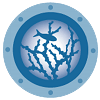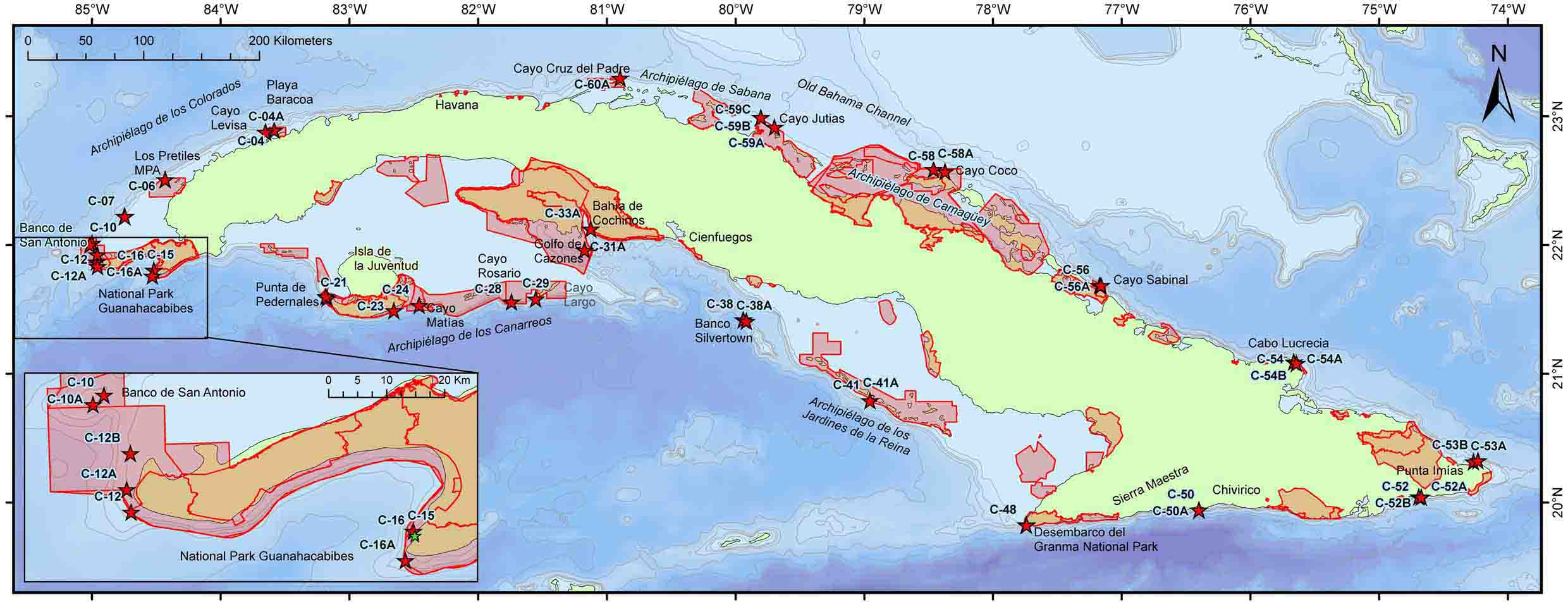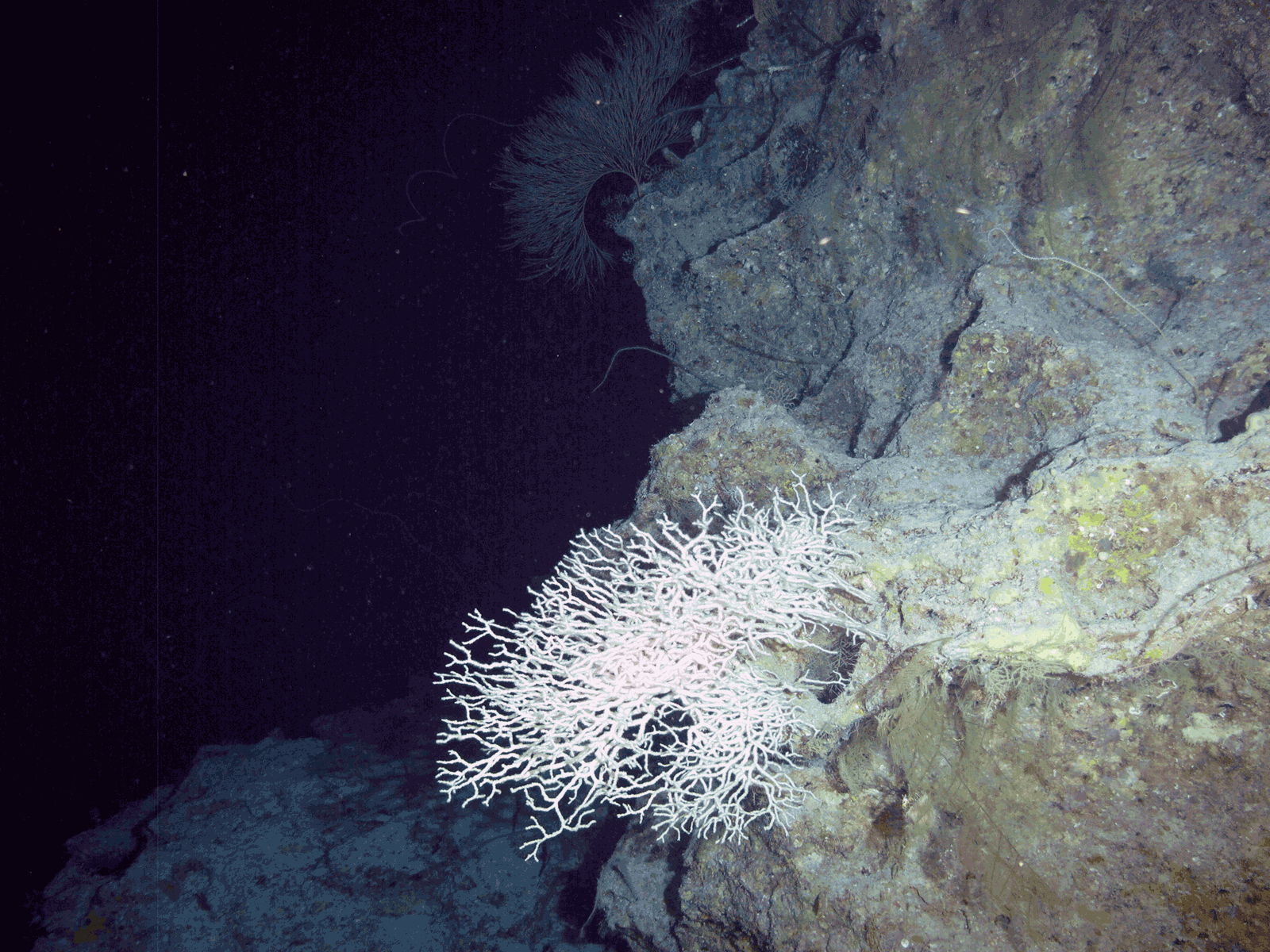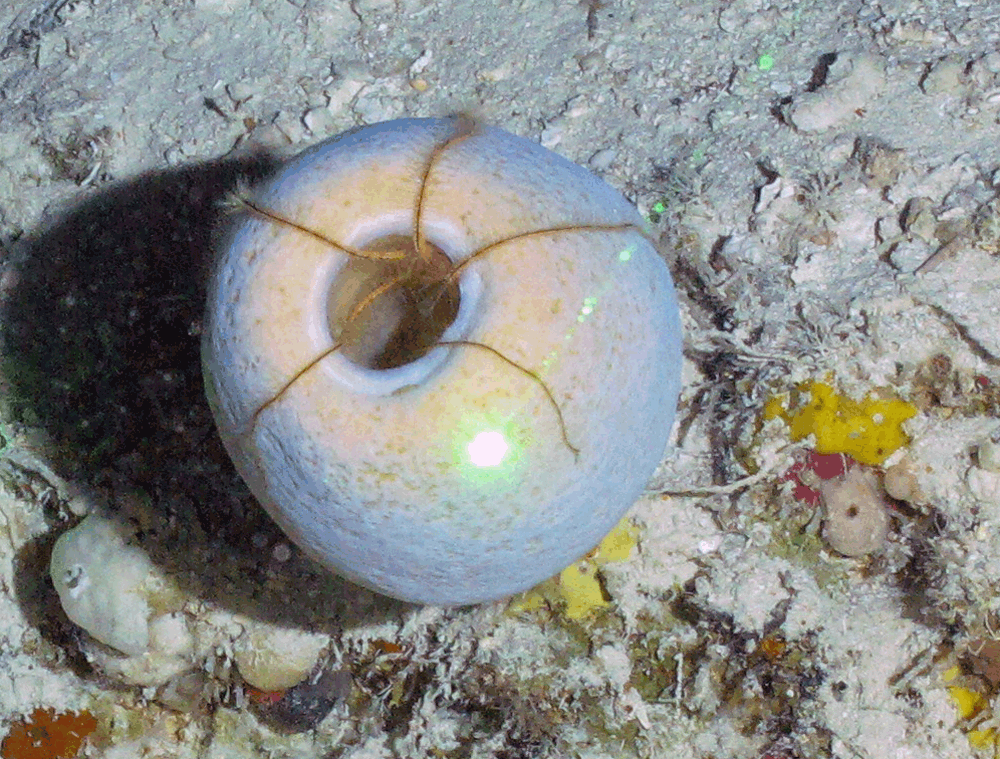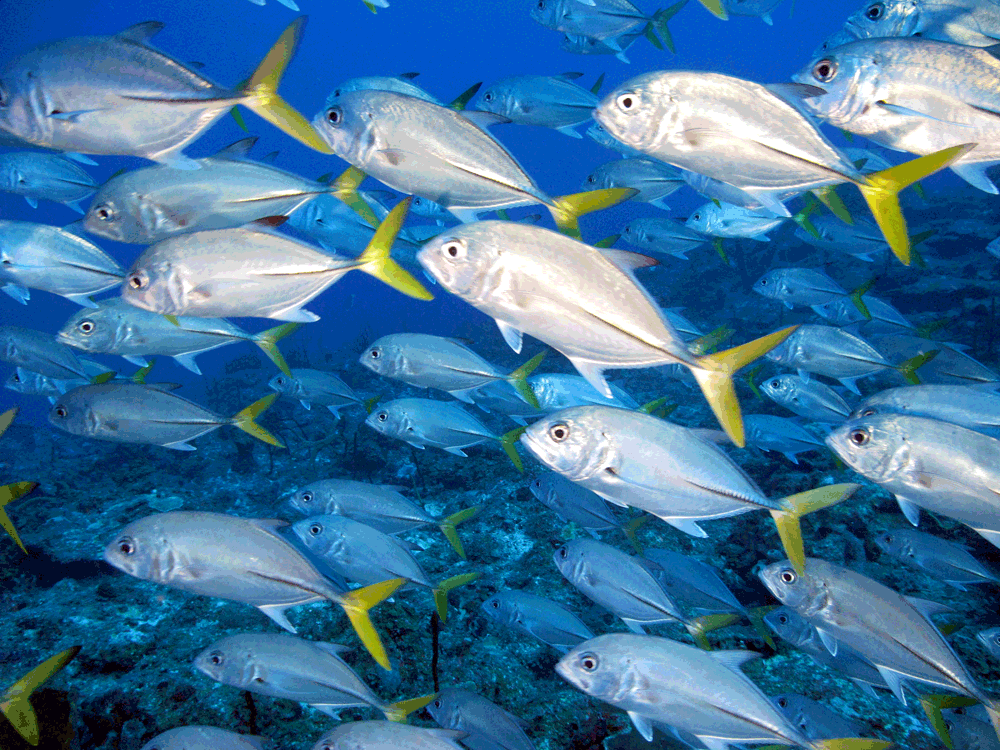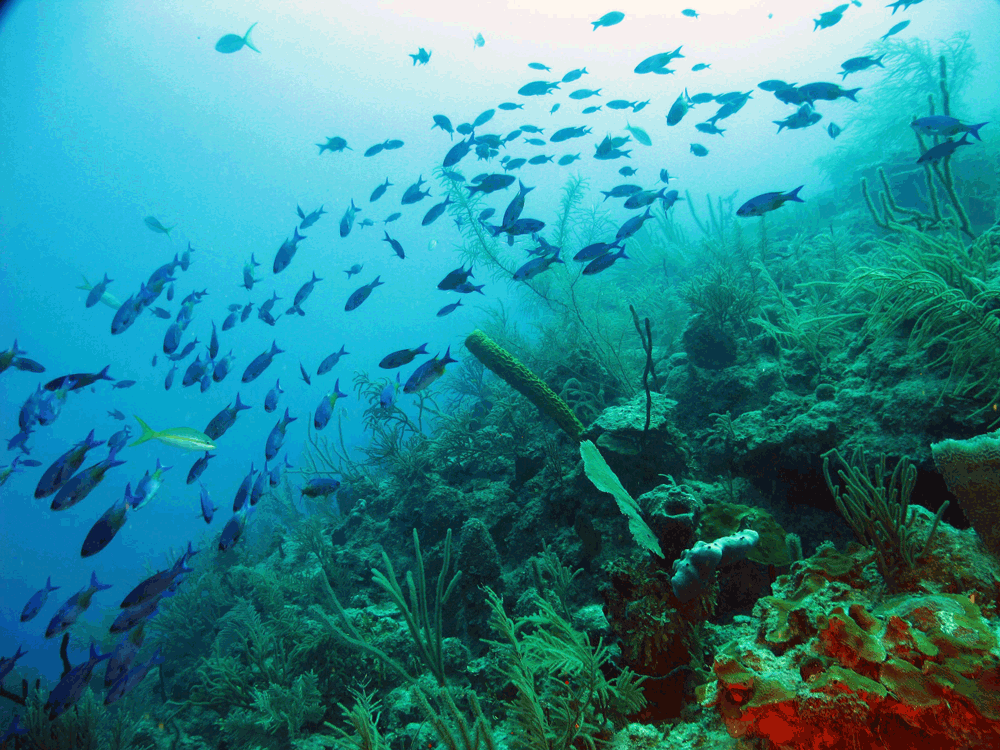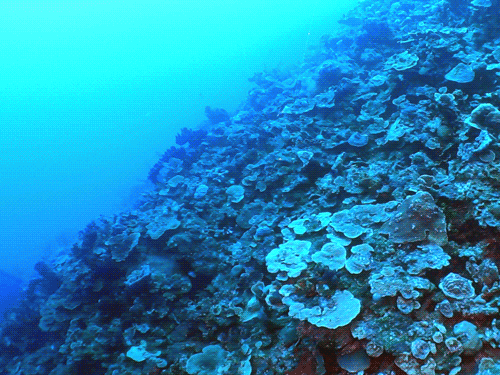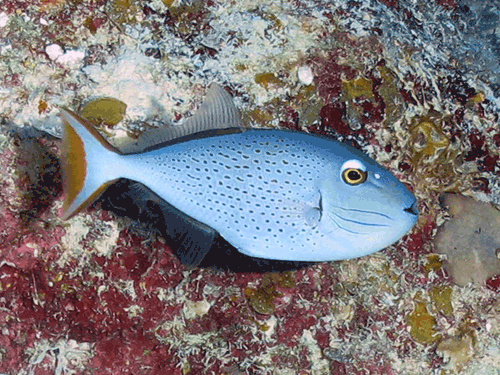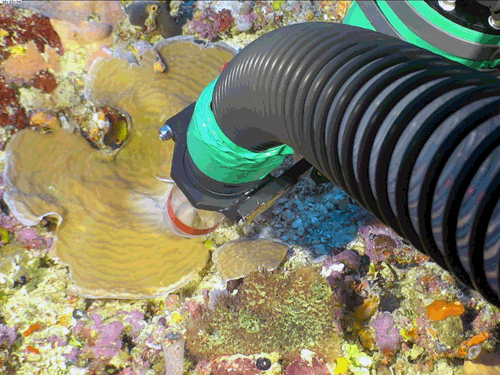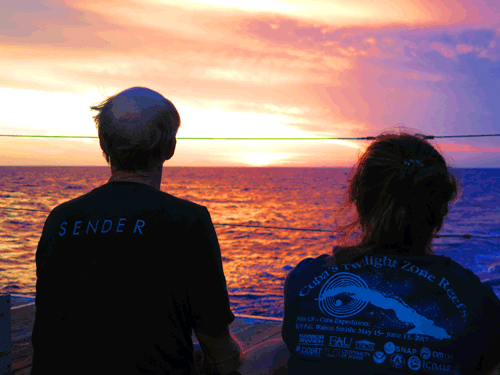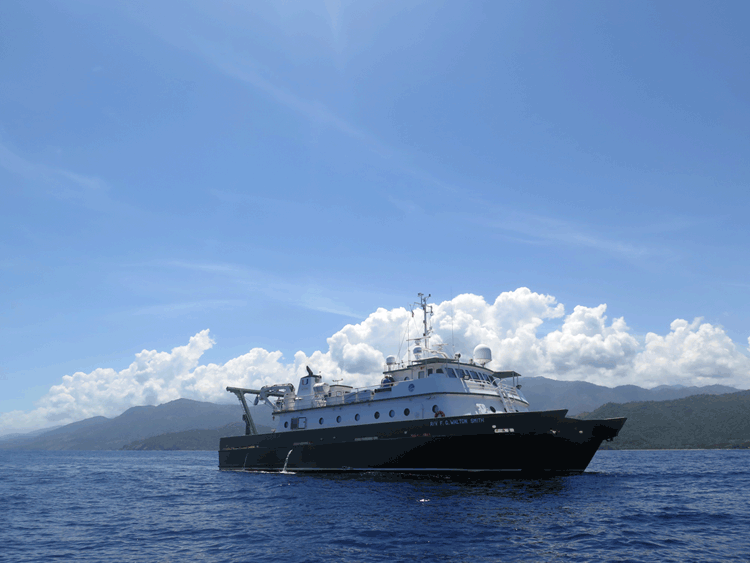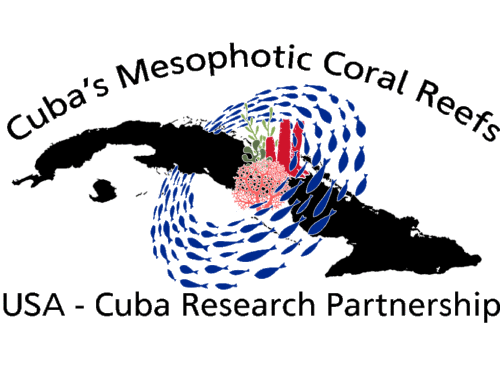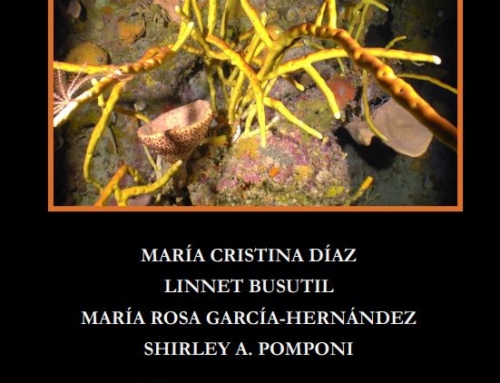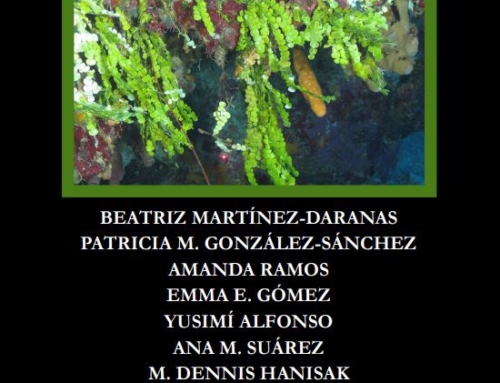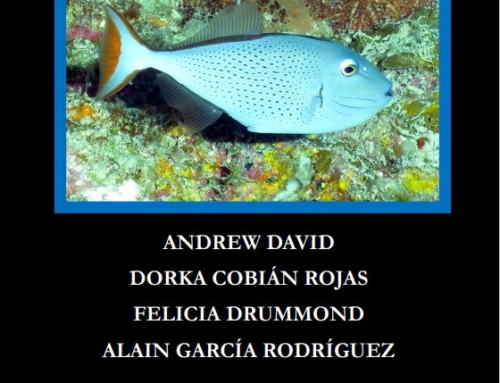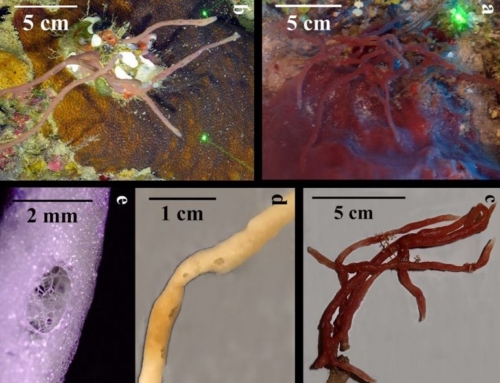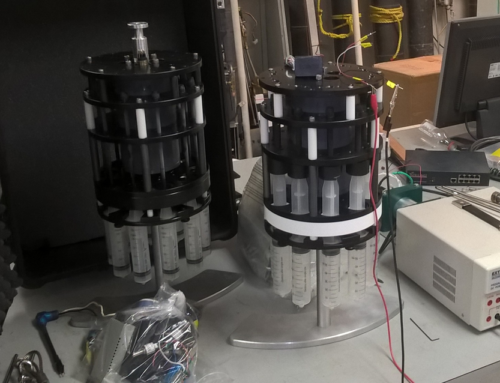Project Description
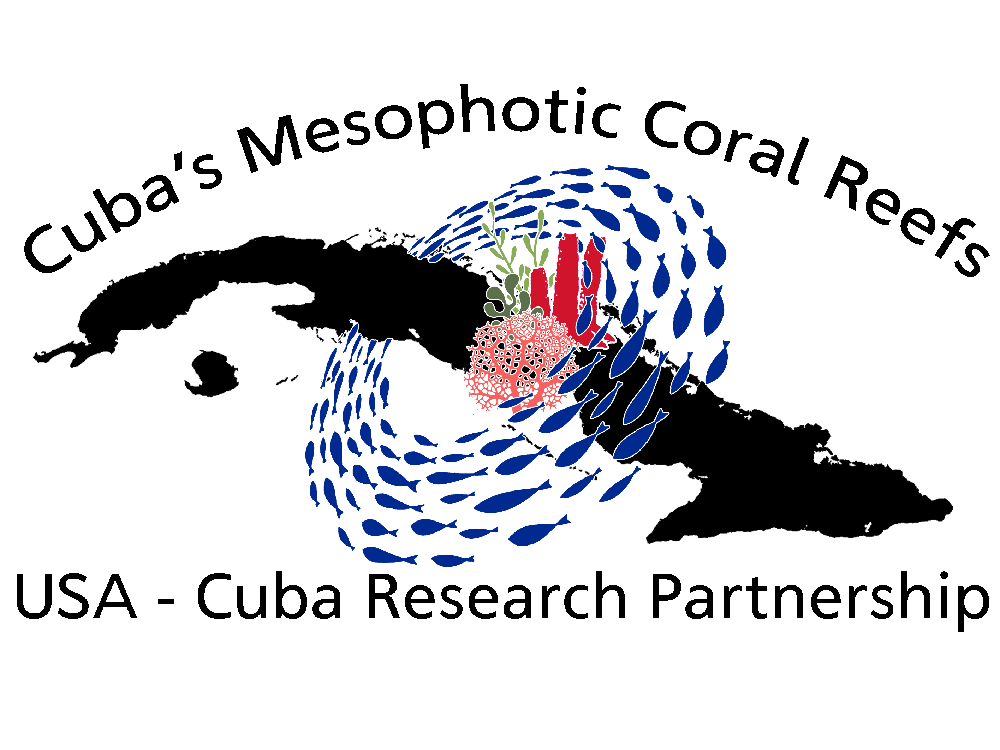
Cuba’s Mesophotic Coral Reefs is a collaboration between Cuban and USA scientists’ research on the deep mesophotic coral reefs and fish communities of Cuba.
This US-Cuba Collaboration of Cuba’s Mesophotic Coral Reefs resulted in an expedition on May 14 to June 13, 2017. This cruise was set out to map and characterize, the extent and health of mesophotic coral ecosystems (MCEs) along the entire coastline of Cuba. Over the one month cruise we transited ~2,778 km (~1,500 nmi). Forty-three Remotely Operated Vehicle (ROV) dives at 36 different stations confirmed the presence of MCEs habitat on all coasts of Cuba (Figure 1; Reed et al. 2018). ROV dives surveyed reefs from depths of 188 m to 18 m, covering 27 km, totaled 99 hours of bottom time, and 110 hours of high-definition video. Check out our Daily Mission Logs.
Mesophotic Coral Reef Ecosystems
Mesophotic coral reef ecosystems (MCEs) are light-dependent benthic communities that occur deeper than shallow reefs and typically range from depths of 30 m to the bottom of the photic zone, which may extend to >150 m in some regions. MCEs represent in part an extension of shallow-water coral reef ecosystems and support a diverse assemblage of habitat-building taxa, including corals, sponges and algae, and associated commercial and recreational fisheries (Reed, González-Díaz, Busutil 2018).
Discovery
A total of 21,146 digital still images documented habitat and species. The primary geomorphological features were the Deep Island Slope (125- >150 m), Deep Fore-Reef Escarpment (the ‘Wall’, 50-125 m; Figure 2), and Deep Fore-Reef Slope (30-50 m). Most vertical surfaces of the Wall were covered with dense sponges, algae, octocorals (soft corals), and black corals. Agaricia was the most abundant hard coral on the Wall at depths of 50-75 m, and was seen as deep as 122 m. A total of 343 specimens were collected including several new species of sponges (Busutil et al. 2018 & Figure 3).
A total of 477 taxa of benthic macrobiota and 178 fish species were identified from the ROV video/photo surveys and from the specimens collected. These included 296 sponge taxa, 46 Scleractinia (hard corals), and 63 macroalgae.
Deep Reef Refugia Hypothesis
Many MCEs worldwide appear to be thriving compared to shallow reefs. The deep reef refugia hypothesis suggests that MCEs may be less impacted from natural and anthropogenic impacts than shallow coral reefs, and may be more stable and resilient than shallow reefs. MCEs may also act as refugia for shallow reef species through the export of fish and coral larvae. However, it is now apparent that MCEs are also vulnerable to disturbances from all facets of perturbations including climate change, bottom trawling, invasive species, and pollution.
Relatively little is known about the distribution, community structure and health of Cuba’s deep mesophotic reefs despite considerable data having been reported regarding the distribution, ecology, and health of Cuba’s shallow reefs world wide. Cuba’s strong marine policies and legislation has already resulted in 105 Marine Protected Areas (MPAs), covering nearly 25% of its insular shelf, yet overfishing, poaching, pollution and global warming are threats to these vulnerable ecosystems, as reefs worldwide are threatened.
Centro de Investigaciones Marinas, Universidad de La Habana, Cuba
- Patricia González-Díaz, Co-Chief Scientist
- Beatriz Martínez-Daranas
Instituto de Ciencias del Mar, La Habana, Cuba
- Linnet Busutil, Co-Chief Scientist
- Alain García Rodríguez
ECOVIDA-Sistema Nacional de Areas Protegidas, Pinar del Río Province, Cuba
- Dorka Cobián Rojas
Centro Nacional de Áreas Protegidas, La Habana, Cuba
- Juliett González Mendez
Acuario Nacional de Cuba, La Habana, Cuba
- Patricia M. González- Sánchez
Geocuba Estudios Marinos, La Habana, Cuba
- Jorge Viamontes Fernández
- Daniel Estrada Pérez
Cooperative Institute for Ocean Exploration, Research, and Technology, Harbor Branch Oceanographic Institute, Florida Atlantic University
- John K. Reed, Co-Chief Scientist
- Stephanie Farrington
- Joshua Voss
- M. Dennis Hanisak
- Cristina Diaz
- Mingshun Jiang
- Michael Studivan
NOAA, National Marine Fisheries Service, Southeast Fisheries Science Center, Panama City, Florida, USA
- Andrew David
- Felicia Drummond
University of Miami, Miami, FL
- Captain and Crew of R/V F.G. Walton Smith
University of North Carolina at Wilmington (UNCW-CIOERT), Undersea Vehicle Program
- Lance Horn
- Jason White
Conference Abstracts and Posters
The following documents are available for download and include conference abstracts and posters. Coming soon: Masters’ Theses and PhD Dissertations resulting from this research.
Abstracts
- 2018 Gordon Research Conference, Mesophotic Coral Reef Ecosystems. Bates College, Lewiston, ME. June 17-22, 2018. Joshua Voss. Coral connectivity and symbiosis among mesophotic coral reefs in the Gulf of Mexico and Northwestern Caribbean. Abstract and presentation.
- 2018 4th International Workshop On Taxonomy Of Atlanto-Mediterranean Deep-Sea & Cave Sponges. September 10-15, Station Marine d’Endoume, Marseille. Cuban Mesophotic Reef Sponges: Challenges, Novelties, and Opportunities – Part I: Major habitats and Haplosclerida (Demospongiae) diversity. Linnet Busutil, Shirley A. Pomponi, María R. García–Hernández & María Cristina Díaz. Download PDF
- 2018 4th International Workshop On Taxonomy Of Atlanto-Mediterranean Deep-Sea & Cave Sponges. September 10-15, Station Marine d’Endoume, Marseille. Cuban Mesophotic Reef Sponges: Challenges, Novelties, and Opportunities – Part II: Demospongiae, Homosclerophorida, and Calcarea Diversity. María Cristina Díaz, Shirley A. Pomponi, María R. García–Hernández & Linnet Busutil. Download PDF
- 12th Convención Internacional sobre Medio Ambiente y Desarrollo, June 1-5, 2019. La Habana, Cuba. Caracterización de los arrecifes mesofóticos en áreas marinas protegidas en el oeste de Cuba, Dorka Cobian Rojas, John Reed, Patricia Gonzalez-Diaz, Linnet Busutil, Stephanie Farrington, Beatriz Martinez-Daranus, Cristina Diaz, Andrew David, Jore Viamontes Fernandez, Mingshun Jiang, Shirley Pomponi.
- 12th Convención Internacional sobre Medio Ambiente y Desarrollo, June 1-5, 2019. La Habana, Cuba. Esponjas de los arrecifes de coral mesofóticos de Cuba: una guía fotográfica para el estudio de su biodiversidad y ecología, Linnet Busutil, M. Cristina Diaz, Maria R. Garcia-Hernandez, Shirley A. Pomponi, Stephanie Farrington, John K. Reed.
MarCuba Abstracts
- 2018 MarCuba, 11th Congress on Marine Sciences, October 2018, Havana, Cuba. Reed, John, Patricia González-Díaz, Linnet Busutil, Stephanie Farrington, et al., 2018. Cuba’s mesophotic coral reefs and associated fish communities. Abstract and presentation. Download PDF
- 2018 MarCuba, 11th Congress on Marine Sciences, October 2018, Havana, Cuba. Martínez-Daranas, Beatriz, M. Dennis Hanisak, Patricia González-Sánchez, Yusimí Alfonso, Amanda Ramos, Emma E. Gómez and Ana M. Suáre. Macroalgal distribution in Cuban mesophotic coral reefs: first results. Abstract and presentation. Download PDF
- 2018 MarCuba, 11th Congress on Marine Sciences, October 2018, Havana, Cuba. Cobián, Dorka, Andrew David, Alain García, Felicia Drummond. Caracterización De Las Comunidades De Peces En Los Arrecifes Mesofóticos De Cuba; Characterization Of Fish Communities In The Mesophotic Reefs Of Cuba. Abstract and presentation. Download PDF
- 2018 MarCuba, 11th Congress on Marine Sciences, October 2018, Havana, Cuba. Pomponi, Shirley, Cristina Diaz, Maria Garcia-Hernandez, Linnet Busutil. Biodiversity and connectivity of sponges from Cuba and southwest Florida mesophotic coral ecosystems. Abstract and presentation. Download PDF
- 2018 MarCuba, 11th Congress on Marine Sciences, October 2018, Havana, Cuba. Díaz, M. Cristina, Linnet Busutil, María R. García–Hernández and Shirley A. Pomponi. The challenge of the mesophotic coral reef sponges from Cuba: A strategy for the study of an unexplored multispecific sponge aggregation (2017- 2018). Abstract and presentation. Download PDF
- 2018 MarCuba, 11th Congress on Marine Sciences, October 2018, Havana, Cuba. Voss, Joshua D., Silvia Patricia González Díaz, Juliett González Méndez, Alexis B. Sturm, Ryan J. Eckert, Michael S. Studivan, John K. Reed. Mesophotic coral community variation and connectivity in Cuba, the Gulf of Mexico and Belize. Abstract and presentation. Download PDF
- 2018 MarCuba, 11th Congress on Marine Sciences, October 2018, Havana, Cuba. Busutil, Linnet. María R. García–Hernández, M. Cristina Díaz, Shirley A. Pomponi. Esponjas de arrecifes coralinos mesofóticos: nuevos reportes para Cuba y dos nuevas especies para la ciencia. Abstract and presentation. Download PDF
- 2018 MarCuba, 11th Congress on Marine Sciences, October 2018, Havana, Cuba. Reed JK, González-Díaz P, Busutil L, Farrington S, Martínez-Darana B, Cobián D, Voss J, Diaz C, David A, Hanisak MD et al. 2018. Cuba’s mesophotic coarl reefs– geomorphology and biodiversity. Downlaod PDF
Posters
- 2018 AGU Ocean Science Meeting, Feb 13-16, 2018, Portland, Oregon. Jiang, M.S., Leticia Barbero, Fraser Dalgleish, Jason White, John Reed. Measuring fine-scale variability of carbonate chemistry over mesophotic coral reefs in Cuban waters using an integrated ROV-sensor system. Poster. Download PDF
- 2018 Benthic Ecology Meeting, Corpus Cristi, Texas, March 2018. Sturm AB, González Méndez J, Eckert RJ, Studivan MS, González Díaz SP, and Voss JD. Assessing population connectivity of the coral species, Montastraea cavernosa, across various spatial scales in Cuba and the Tropical Western Atlantic. Poster. Download PDF
- Sturm AB, Méndez JG, Eckert RJ, Chei E, Dodge DL, Studivan MS, Díaz SPG, Voss JD. 2018. Assessing population connectivity of the coral species, Montastraea cavernosa, in Cuba and the Tropical Western Atlantic. MarCUBA; 2018; Havana, Cuba. Download PFD
For more info also see Florida Atlantic University Digital Library & Harbor Branch Oceanographic Institute
Publications & Cruise Reports
The following publications & cruise reports are available for download:
Publications
- Reed, John K., Patricia González-Díaz, Linnet Busutil, Stephanie Farrington, Beatriz Martínez-Daranas, Dorka Cobián Rojas, Joshua Voss, Cristina Diaz, Andrew David, M. Dennis Hanisak, Juliett González Mendez, Alain García Rodríguez, Patricia M. González- Sánchez, Jorge Viamontes Fernández, Daniel Estrada Pérez, Michael Studivan, Felicia Drummond, Mingshun Jiang, Shirley A. Pomponi. 2018. Cuba’s mesophotic reefs and associated fish communities. Revista de Investigaciones Marinas 38 (1): 56- 125. ISSN: 1991-6086. Harbor Branch Oceanographic Institute Contribution Number 2151. Download PDF
- Busutil, L., M. Garcia-Hernandez, C. Diaz, S. Pomponi. 2018. Mesophotic sponges of the genus Callyspongia (Demospongiae, Haplosclerida) from Cuba, with descriptions of two new species. Zootaxa 4466(1): 78-94, ISSN 1175-5334 Download PDF
- David, Andrew, Dorka Cobián Rojas, Felicia Drummond, Alain García Rodríguez. 2018. Cuba’s Mesophotic Reefs- Fish Photo Identification Guide; editors- John K. Reed, Stephanie Farrington. Cooperative Institute for Ocean Exploration, Research and Technology (CIOERT) at Harbor Branch Oceanographic Institute-Florida Atlantic University (HBOI-FAU). First Edition: October 2018. Ironside Press, Vero Beach, Florida. HBOI Contribution Number 2188. Download PDF
- Martínez-Daranas, Beatriz, Patricia M. González-Sánchez, Amanda Ramos, Emma E. Gómez, Yusimí Alfonso, Ana M. Suárez, M. Dennis Hanisak. 2018. Cuba’s Mesopho-tic Coral Reefs- Macro Algae Photo Identification Guide: Editors- John K. Reed, Stephanie Farrington. Cooperative Institute for Ocean Exploration, Research, and Technology (CIOERT) at Harbor Branch Oceanographic Institute- Florida Atlantic University (HBOI-FAU). First Edition: November 2018. Ironside Press, Vero Beach, Florida. HBOI Contribution Number 2192. Download PDF
- Díaz, María Cristina, Linnet Busutil, María Rosa García-Hernández, and Shirley A. Pomponi. 2019. Cuba’s Mesophotic Coral Reefs- Sponge Photo Identification Guide, Edition 1; Editors- John K. Reed, Stephanie Farrington. Cooperative Institute for Ocean Exploration, Research, and Technology (CIOERT) at Harbor Branch Oceanographic Institute, Florida Atlantic University (HBOI-FAU). First Edition: June 2019. Harbor Branch Oceanographic Institute Contribution Number 2256. Download PDF
- Sturm AB, Eckert RJ, Méndez JG, González-Díaz P, Voss JD. 2020. Population genetic structure of the great star coral, Montastraea cavernosa, across the Cuban archipelago with comparisons between microsatellite and SNP markers. Scientific Reports. 10(1). http://dx.doi.org/10.1038/s41598-020-72112-5. Download PDF
Cruise Reports
- Reed, John, Stephanie Farrington, Patricia González-Díaz, Linnet Busutil López, Beatriz Martínez-Daranas, Dorka Cobián Rojas, Joshua Voss, M. Dennis Hanisak, Cristina Diaz, Mingshun Jiang, Andrew David, Felicia Drummond, Michael Studivan, Juliett González Mendez, Alain García Rodríguez, Jorge Viamontes Fernández, Lance Horn, Jason White, Shirley Pomponi. 2017. Cuba’s Twilight Zone Reefs: Remotely Operated Vehicle Surveys of Deep/Mesophotic Coral Reefs And Associated Fish Communities of Cuba, Joint Cuba-U.S. Expedition, R/V F.G. Walton Smith, May 14- June 13, 2017. NOAA CIOERT Report to NOAA Office of Ocean Exploration and Research, 510 pp. Harbor Branch Oceanographic Technical Report Number 183. Download PDF
Data
- Smith R, Reed J, Jiang M, Farrington. S. 2020. Ocean Velocity collected from R/V F. G. WALTON SMITH in Cuba, Northwestern Caribbean Sea, and others from 2017-05-14 to 2017-06-13. . NOAA National Centers for Environmental Information (NCEI), Reference ID: UHM6D4. ftp://ftp.aoml.noaa.gov/phod/pub/rsmith/sadcp_archive/final_products/WS17135
For more info also see Florida Atlantic University Digital Library & Harbor Branch Oceanographic Institute
Supported By
- NOAA Office of Ocean Exploration and Research Award number NA14OAR4320260 to the Cooperative Institute for Ocean Exploration, Research and Technology (CIOERT) at Harbor Branch Oceanographic Institute-Florida Atlantic University (HBOI-FAU),
- NOAA Pacific Marine Environmental Laboratory under award number NA150AR4320064 to the Cooperative Institute for Marine and Atmospheric Studies (CIMAS) at the University of Miami.
- This expedition was conducted in support of the Joint Statement between the United States of America and the Republic of Cuba on Cooperation on Environmental Protection (November 24, 2015) and the Memorandum of Understanding between:
- the United States National Oceanic and Atmospheric Administration
- the U.S. National Park Service, and Cuba’s National Center for Protected Areas.
Special Thanks:
We give special thanks for assistance in securing the necessary permits to conduct the expedition and for their tremendous hospitality and logistical support in Cuba:
- Carlos Díaz Maza (Director of the National Center of Protected Areas)
- Ulises Fernández Gomez (International Relations Officer, Ministry of Science, Technology and Environment; CITMA)
We also thank:
- Captain and crew of the University of Miami R/V F.G. Walton Smith
- ROV operators Lance Horn and Jason White, University of North Carolina at Wilmington (UNCW-CIOERT), Undersea Vehicle Program for their excellent work at sea during the expedition. The Mohawk ROV is owned by the NOAA National Marine Sanctuaries Foundation.

